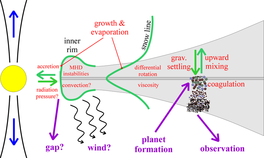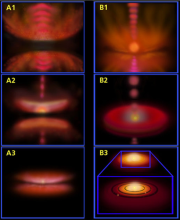The DIANA project aims at setting a new, high standard to the systematic analysis and exploitation of space mission data in the field of star and planet formation. Currently, a growing amount of observational material is collected, but these expensive data are not sufficiently harvested in terms of modelling and interpretation. This is due to a current structural weakness of national and European research funding in astronomy, where resources are mainly spent for new observational platforms, instruments and observations, but even for the major granted observational programmes there is no automatism for the funding of theorists to exploit the data.
Too often, the expensive space data end up in archives and remain unused.
The proper interpretation of observations from protoplanetary discs is a challenging task. The different observable spectral fluxes, images and line profiles originate in different parts of the discs, where densities are different by 10 orders of magnitude and temperatures range from about 10000 K to 10 K. High-energy processes like stellar activity, mass accretion and jet acceleration close to the star create an X-ray and UV irradiation of the discs which heat the discs at large radii and affect the chemistry and line formation, depending on how much of that irradiation can pass, or is rather scattered around, the disc’s inner rim.
This FP7 project will produce a number of deliverables aiming at progress in science.
Disc structure and evolution
We will build up a new internet portal to host our multi-wavelength observations (Deliverable 1.1). This portal will be opened for public access after the project is completed. These data include all kinds of calibrated observational data sets like photometric fluxes, low to high resolution spectra, interferometric and image data as well as observed line profiles and channel maps for about 40-50 carefully selected targets with sufficient data overlap. Our internet portal will facilitate the access to and ensure the appropriate use of the data for other researchers outside of the team.

Credits: ASTR 1210 (O’Connell) Study Guide
WP 2 will produce best-fitting disc structures including stellar parameters, surface density distributions (including potential gaps), dust and gas densities and temperatures, disc shape and spatial distributions of a large set of atoms/molecules/ices within the disc (Deliverable 2.2) for all individual objects in our target list. These results will be added to our internet portal for further analysis outside and beyond this project and to give researchers in adjacent science fields access to our results.
WP 6 will produce large systematic grids of disc models as function of stellar type and age (Deliverables 6.1 and 6.3).
This data will also become public available after project completion here, useful for field studies and surveys.
Disc physics and chemistry
Our modelling software is online available for public use on a collaborative basis (Deliverable 2.1).
- ProDiMo → you can register here to download the source code
- MCFOST → contact Christophe Pinte
- MCMax → contact Michiel Min
- FLiTs → contact Michiel Min

Some important physical and chemical processes
in protoplanetary discs, (© P. Woitke 2008).
Our work in WP 3 will result in an X-ray radiative transfer software module for ProDiMo (Deliverable 3.1).
Our work in WP 4 will result in an improved treatment of the inner dust rims of protoplanetary discs (Deliverable 4.1). This is currently a highly controversial topic and our conclusions in form of scientific papers, based on the interferometric observations and multi-λ models, can be expected to set new standards for the science community.
Our work in WP 5 will result in a fast molecular line ray tracer to for IR molecular lines, as observed by Spitzer, such as H2O, OH, CO2, HCN, and C2H2.
The public distribution of our modelling software is expected to have a lasting impact on future theoretical studies of protoplanetary discs.
Dust evolution and planet formation

Our modelling will give new scientific insight into the prevailing conditions in the discs, such as dust and gas temperatures, chemical composition, degree of ionisation, abundance of ices, dust properties, even for the optically thick midplane which is not accessible to any direct observations. These results, based on 40-50 carefully selected and individually fitted objects, will be made accessible to the community through this internet portal at the end of the project. Our intention here is to invite external scientists to challenge their planet formation models with.
Artist’s conception of three evolutionary states 1, 2, 3 seen from edge-on (A, left) and tilt halfway (B, right). Credits: STScI.
Planet formation and migration

Current hydrodynamical models for planet migration (e.g. Paardekooper & Mellema 2006), viscous disc evolution (Lynden-Bell & Pringle 1974, Hartmann et al. 1998), and planet formation via gravitational instabilities (Rice & Armitage 2009) suffer from a very basic uncertainty, namely the poor treatment of radiative transfer effects. In particular the effect of gas emission lines as cooling mechanism to compensate viscous heating is completely ignored in these models. Our detailed modelling of the dust and gas energy balance allows us to calculate detailed heating and cooling timescales, and during the course of the project we aim at the production of numerical look-up-tables (Deliverable 6.4), that can be included in hydrodynamical disc simulations.